All the joys of early Spring
Tuesday, April 4, 2017
Although variable weather was a feature of the month, it did not
hold back the advance of Spring. Right on cue, there were
lambs everywhere, frog tadpoles hatching, grass growing, the first
magnolias, longer daylight hours, and in the gardens and
surrounding countryside all the plants we expect to see at this
time of year. A much earlier spring than last year.

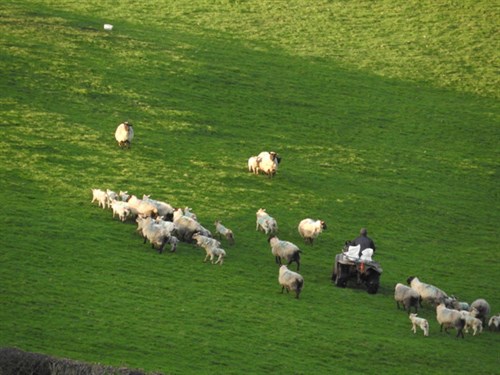
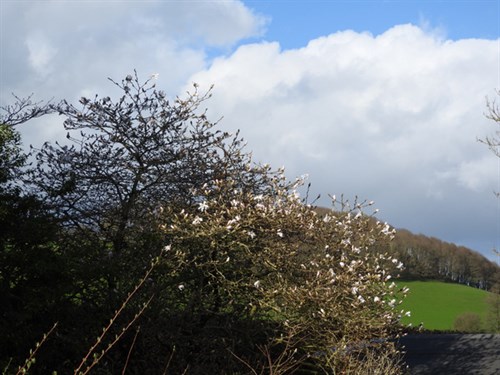
Daffodils
One of the cornerstone plants is of course the daffodil. They
are so bright and cheerful even on the most gloomy of days. They
have been revered over the centuries in verse and celebrated in
events across the UK. I have however encountered numerous gardeners
over the years for whom the yellow peril is just too much for them
and they avoid planting them; and it isn't only daffodils, but all
yellow plants at any other time of year. Poor souls!!
Up against a intensely yellow house wall it adds
insult to injury!
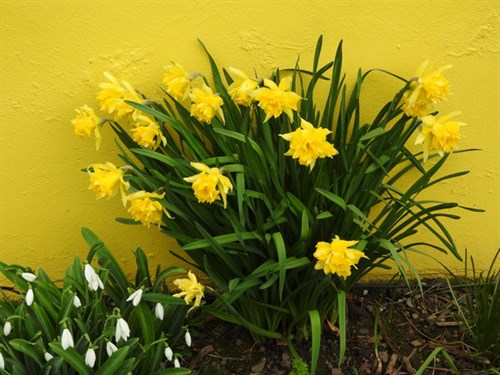
Every year there are more and more daffodil along roadside
verges which is fine with me, unless they are planted in straight
lines or are inappropriate to their setting (like large trumpet
types), as they flop over with heavy rain or strong
winds.
For years I have appreciated the daffodils in gardens, hedges
and farm drives in and around our local community of Myddfai but
never really looked closely at them. This year however all that
changed when I was alerted to the fact that within
Carmarthenshire there is an unusual double daffodil commonly known
locally as the "Derwydd" daffodil, which was first identified some
years ago by botanists in the garden of the Mansion house of
that name, not far from the village of Llandybie, 15 miles away
from us. Botanically it is called Thomas Viriscent. Don't get too
excited because some authorities have labelled it "the most ugly
daffodil in the world"!
There is considerable variation in the flowers between
individual plants and sometimes on the same plant! Streaks of
green are regularly found in the flower and is one of the main
identification features.
This is just one flower head!

Others to my eye are really quite
attractive.
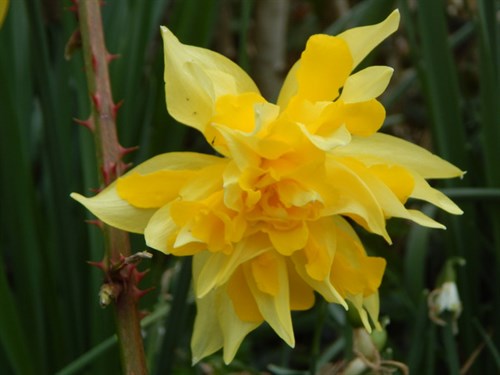
And this one is so different you wonder if it is
the same form. The are many other variations if you study them
close enough
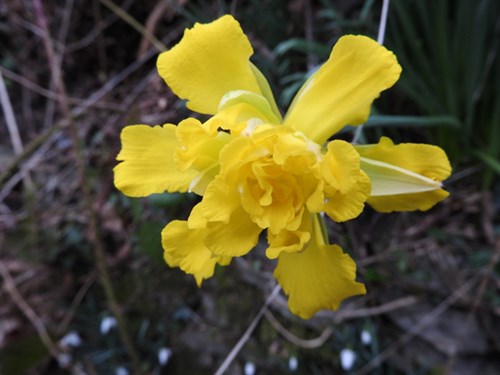
Armed with pictures and much information from internet searches,
I was amazed to find this daffodil at 11 sites within 3 miles from
us ranging from fields, hedgerows, derelict buildings,
graveyards and gardens, including Gelli Mydog, owned by friends
Robert and Barry, where it is the dominant daffodil in a property
that is almost 200 years old.
There are suggestions on the Internet that it might be a wild
daffodil common to parts of West Wales, a double form of
narcissus obvallaris, the Tenby daffodil or our other native
daffodil N. pseudonarcissus. However most authorities consider it
to be a variant of a daffodil known as narcissus "Telamonius
Plenus", a cultivar first recorded 450 years ago. Forms of this
cultivar can be found as far away as USA and Australia.
If all this wasn't complicated enough there is yet another
similar, very old registered cultivar called "Von Sion" introduced
about the same time by a Dutchman of that name. No wonder it is all
Dutch to me!
This very neat, tight double appears in some of the
groups I have found and there is a suggestion that this may be the
true form of "Von Sion"
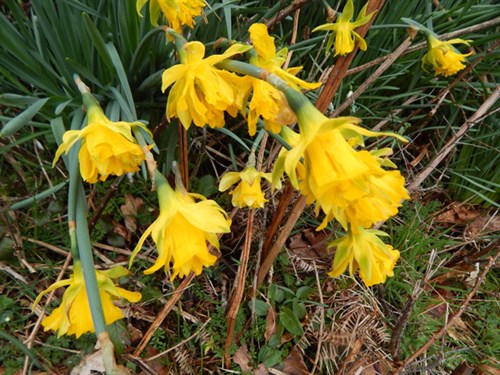
More variations!
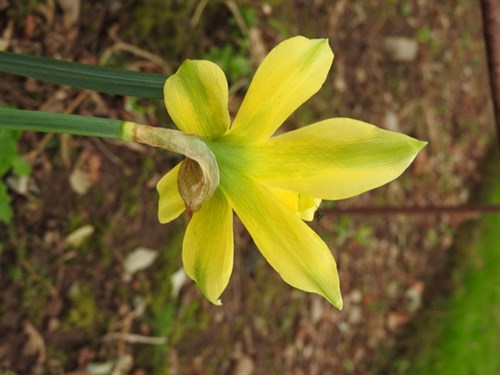
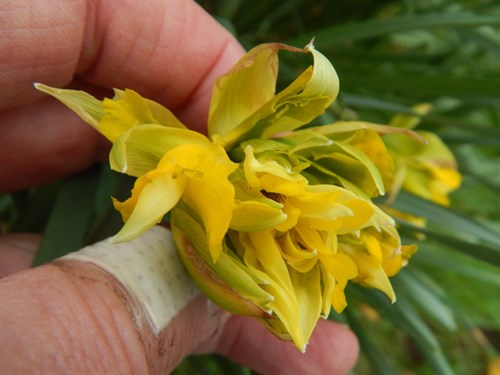
We may never know how they came into being or how they
became distributed around local communities far away from
centres of horticulture - I feel more detective work coming
on!!
As far as I can ascertain there has been no genetic testing of
material from the various forms, assuming of course each of them
can be reliably identified! So we are left with a conundrum which
may never be resolved and various forms of a daffodil that you may
like or not. And just recently on the outskirts of Kidwelly, one of
the oldest towns in Wales, we were introduced to the daffodil again
along the drive to an old farmstead near to our friend Jenny.
who has the woodland full of snowdrops I wrote about last
month.
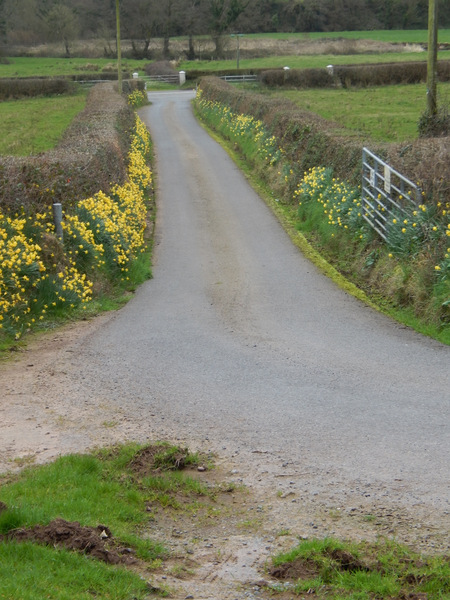
If you really want to know more, just type Narcissus Telamonius
Plenus into you search engine and if you have the time, interrogate
all the pages you can find! There are several nurseries stocking it
if you would like to try some.
Weather
Wind as you would expect in March was a predominant
feature: when it came from the east as it often does at this time
of year, we had generally fine days and cold nights and when in
turned more southerly it was warmer but with some very heavy rain.
There were 24 days with rain or showers, 5 air frosts min
-3C, a max temperature of 16.7C on 30th and 13
other days above 10C.
Very heavy rain on 20th was the heaviest for some months
and caused minor flooding in the Towy Valley a few miles from us
although we were OK
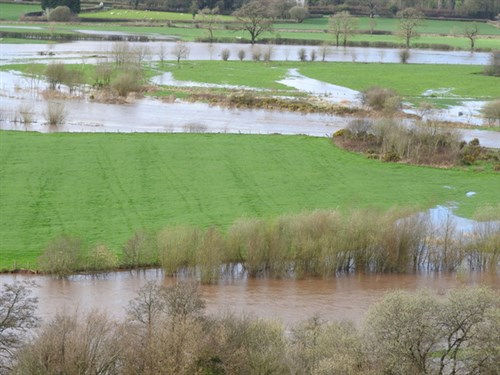
But there were some fine days too.

Garden Update
First mowing of the lawns is always a special time for me (yes I
am that nuts!) as it immediately makes the garden look better, even
more so when the lawn edges are trimmed. Lowering the setting each
time I mow, I completed my 4th cut just before the month end. I
have mentioned in previous news items the benefits of winter high
potash and phosphate lawn feed once in late October and once, if
the weather permits,one in late January, to keep the grass
strong and green.

The vegetable garden is now mostly cleared of overwintered
crops and it is that lean time of year with nothing left to harvest
and only a few root crops still in store. I limed the beds 2 months
ago, except those destined for potatoes. Hopefully the ground will
dry out more in April to permit rotovating. On the evidence of last
years sowings when I didn't commence until the last week of April,
I will let the ground properly warm up before sowing. If you sow
root vegetables in particular too early and it turns cold and wet,
the seeds often die before the germinate
The mammoth task of weeding and tidying all the flower
borders is all but completed thank goodness, ably assisted by
friends Bob and Annette who gave us a whole day of their valuable
time. Bob is the most particular weeder you could ever see,
even using a dining fork to remove the tiniest weeds! They
live right at the end of the Gower peninsular where they grow a
whole range of exotic plants outdoors and this year, amongst many
frost tender plants, they have flowered proteas and leucodendrons
outdoors. They had no frosts at all from November to
March!!
The Koi Pond border after Bob's efforts
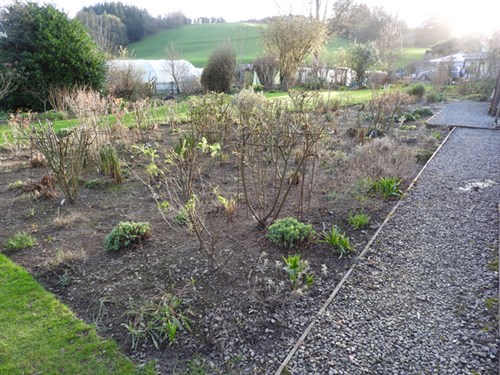
Propagation is well under way from divisions, cuttings and
seeds, and although I vowed to cut back on this aspect of my
gardening life, I just can't stop myself! The polytunnel benches
are filling rapidly and it is time to move out to frames the plants
I overwintered under protection, making more room for cuttings and
seedlings No surely not-I didn't say that did
I?!!

Division of mature plants from stock or in the gardens
is done in Feb and March, but what is this monster- like an escapee
from a sci fi film? Answer at the end. Clue it is not my brain. It
has never been possible to find it!
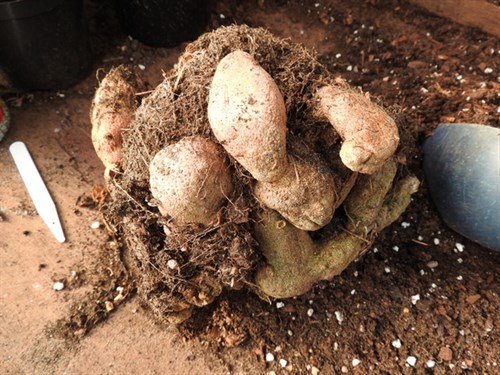
What's looking good?
After all that text some pics now and for those yellow haters,
sorry there are plenty of them!!
But to soften the blow how about this lovely
persian carpet bedding with polyanthus in one of the main streets
of Carmarthen
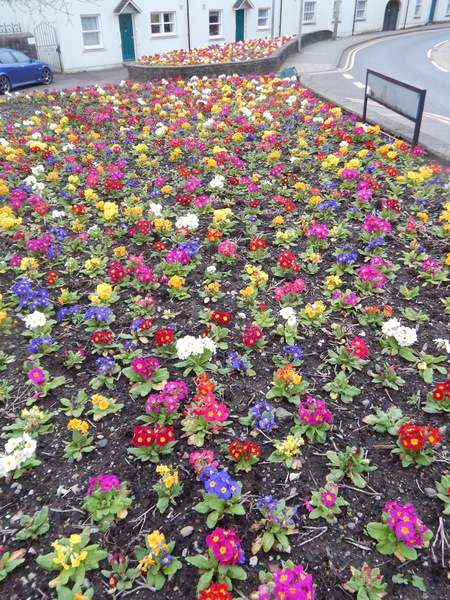
Corylopsis spicata a good spreading shrub with primrose
yellow flowers relative of the native hazels so is a good
doer.

One of the best shrubs for scent at this time of
year is the genus viburnum and for me the most highly scented is V.
carlesii
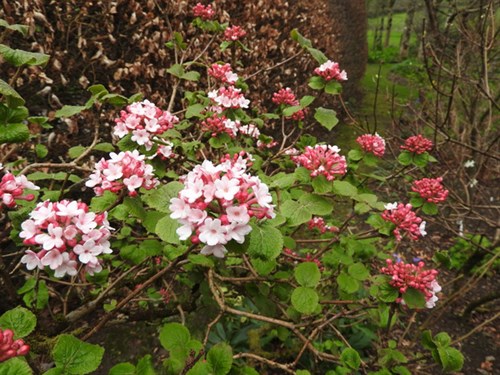
A charming woodlander is hacquetia
epipactis

First flowers on lysichiton americanus the "skunk
cabbage" vivid yellow spathes and very vigorous. Because of
its in vasive habit it can no longer legally be sold or planted but
existing plants are OK
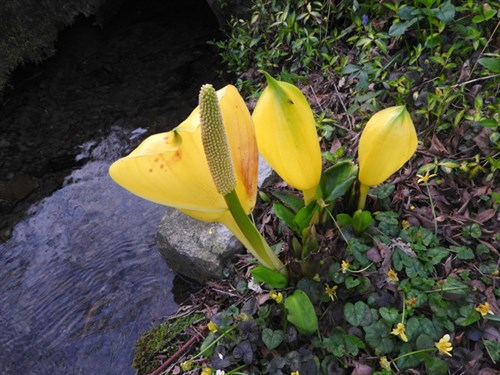
Epimediums are delightful in part shade and we
have several forms here but none I can name.

The complex arrangement of the flowers give them the
common name of Bishops Hat. Also known as Fairy Wings and Barren
Wort.

Cyclaminus hybridus division 6 are my favourite group in
the genus and "Trena" is as good as it gets
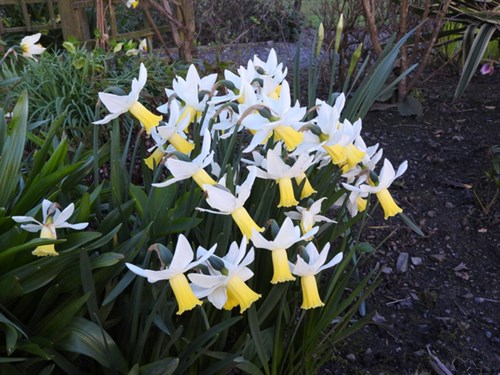
N. "Jenny" has clumped up really well since planting 20
years ago. Starting with a lemon yellow trumpet it ages to
white.
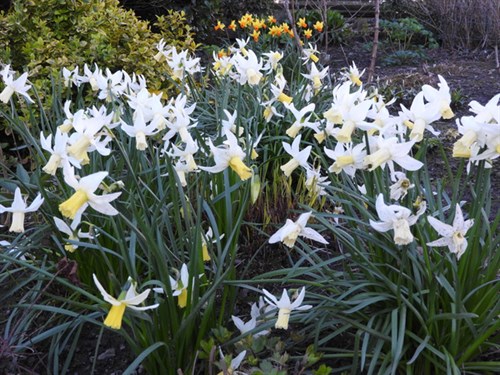
Wildlife and Countryside
The whole valley is full of the sights and sounds of lambing.
with lambs doing all the things their forebears did, including head
butting, racing and chasing, seeing who can jump the highest and
who can pinch milk from the nearest ewe, who may or most likely may
not be their mother. I could watch their antics all day long. Such
a short life for many of them but surely a happy one making the
most of every day.
Making plans for the day!
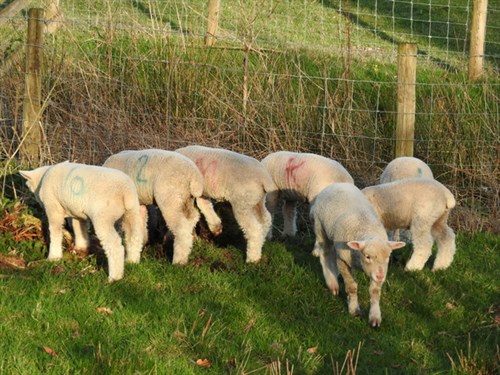
Bird song all day long on fine days, the main
contributions coming from blacbirds, thrush, robins, wrens and the
pesky magpies (hardly birdsong more like a machine gun), which once
again are nesting in the large fir trees in the Paddock Garden.
Bull Finches seem less common now than they were some years ago
and I had a good opportunity to study one at close quarters when it
hit one of the windows of the conservatory, in spite of all the
bird scarers we have in the windows. Fortunately after some hand
warming - always a good way to revive a semi conscious bird - no
damage was done. Researching later on the web I discovered a survey
by one of the bird charities that their numbers are down 30%. No
clear reasons emerged from the survey. They used to be shot or
trapped on fruit farms because of all the damage they can do to
emerging flower buds.
The female bullfinch fully recovered, is rather dowdy
compared to the male, but nevertheless is the boss when it comes to
their relationship! True honestly
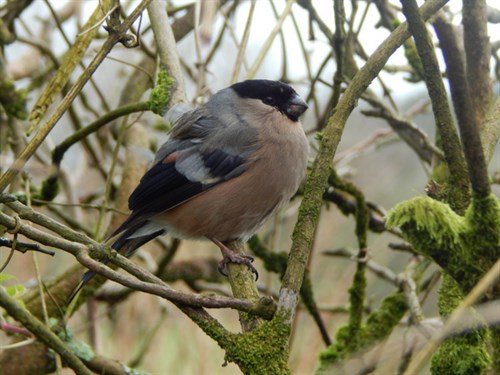
All the frog spawn has hatched with tadpoles everywhere you look
around the Paddock Pond edge. A vast improvement over last year
when following a sharp frost on the newly laid spawn there were
none to be found in the pond. It makes you wonder where all the
frogs came from this year
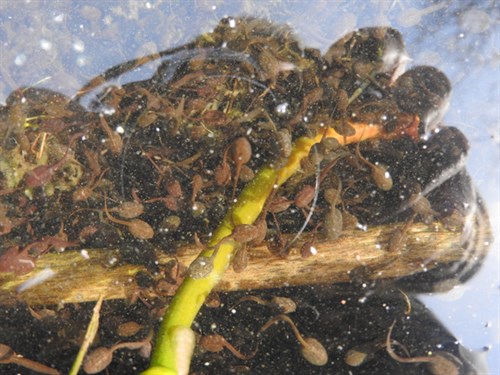
Toads by contrast are nowhere to be seen, just 4 one night in
the Paddock Pond. It was very different 15 or more years ago when
returning home from the office, having swerved to avoid them, I
would regularly go up and down our lane with buckets and a torch
and in the space of 15 minutes or so could fill the buckets with
them for transferance to the pond. It would be interesting to know
if other people with ponds have had a similar experience of much
reduced numbers.
Visits
After last month's seemingly endless round of outings,
only 2 in March - on 2 consecutive days!
Just a part of the very large nursery at Ashwood's which
has many other plant producing green houses and
tunnels.

A trip to Ashwood Nurseries, Kingswinford West Midlands is
always special and we have been going there for 25 years. On this
occasion however it was extra special as our friend Richard Bramley
of Farmyard Nurseries had arranged a day with John Massey, a
horticultural legend and world renowned plantsman who formed the
company 50 years ago. Richard, Matt one of his staff and I had a
very warm welcome from John who in spite of a busy schedule in his
anniversary year, gave us a guided tour of his 3.5 acre gardens
which as you can imagine is packed with masses of rare and unusual
plants, followed by a masterclass on his huge collection of
hepaticas.
L - R Richie, John and Me (not my most elegant pose!)
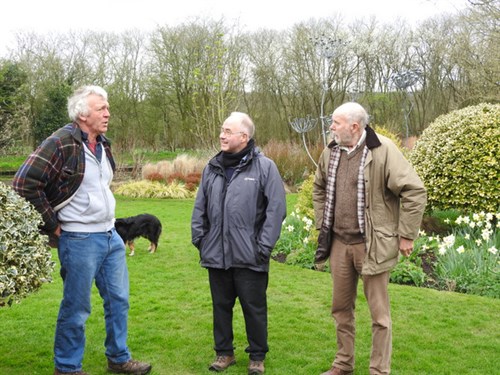
Over lunch he regaled us with plant and people stories
from all his years in horticulture. Good humoured, engaging,
incredibly knowledgeable and holder of the RHS Victoran Medal of
Honour, he seems totally unaffected by all his achievements. It was
an unforgettable experience. To discover more about John and the
nursery go to www.ashwoodnurseries.com
In all I took 150 pics so it was quite a challenge to find just
a few to give a taste of the day.
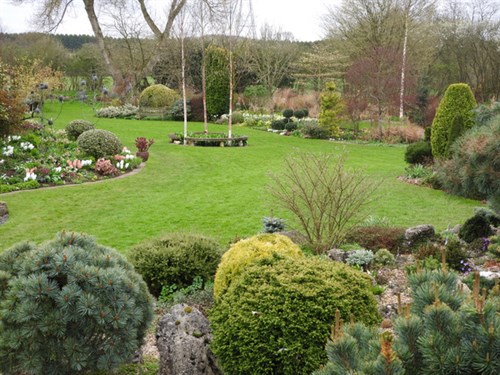

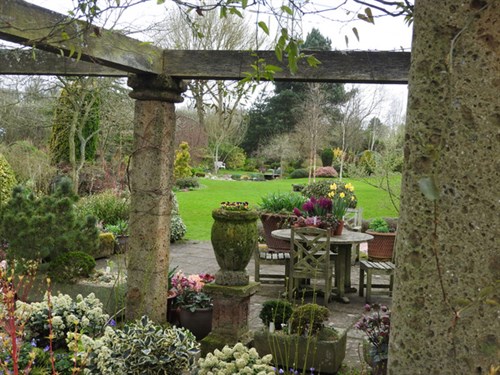
Trillium albidum
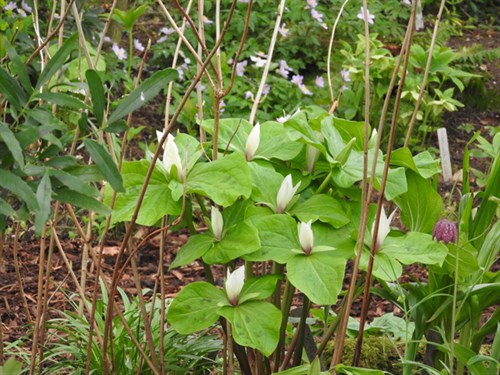
A particularly fine pink erythronium Harvington
strain
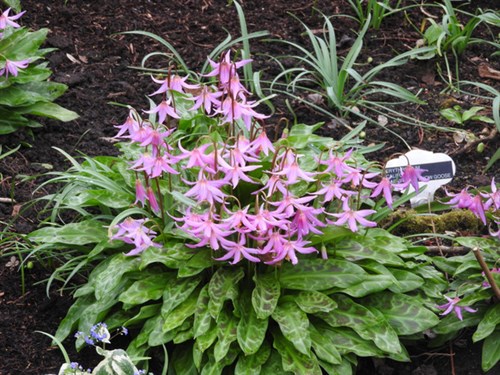

Part of the hepatica collection which won Gold medal and
Best in Show awards at RHS Chelsea Flower Show 2016
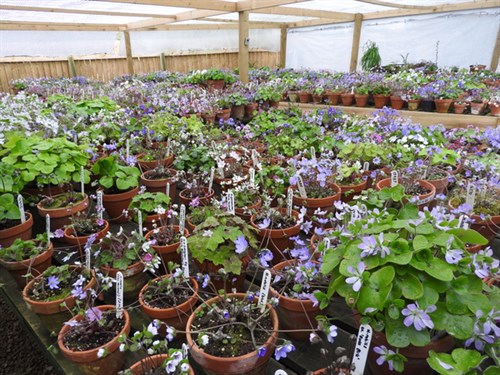
Just a few of the thousands in the main dedicated
greenhouse
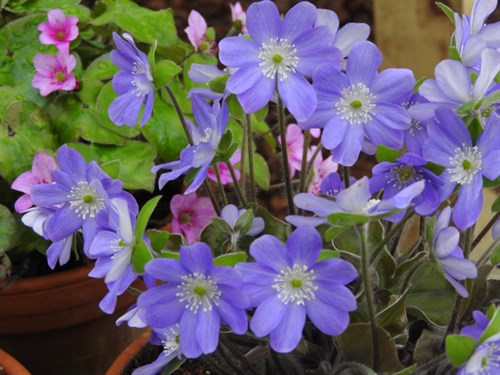
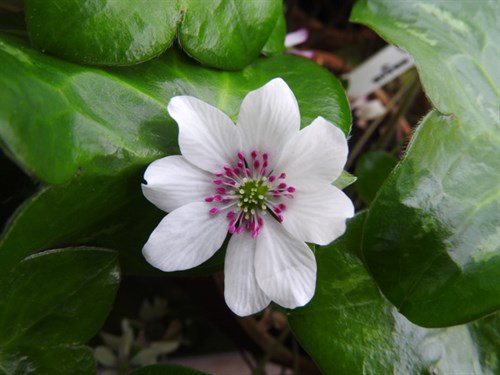
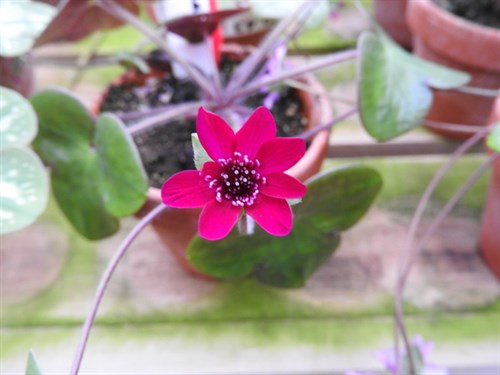
Many of the Japanese forms in particular have some
amazing marbling on the leaves which makes them very
collectable
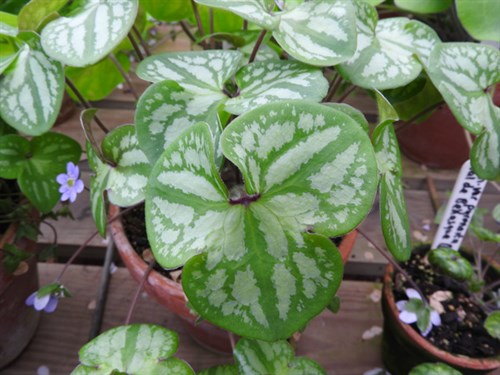
For my taste "Stained Glass" is the most
attractive and most unusual
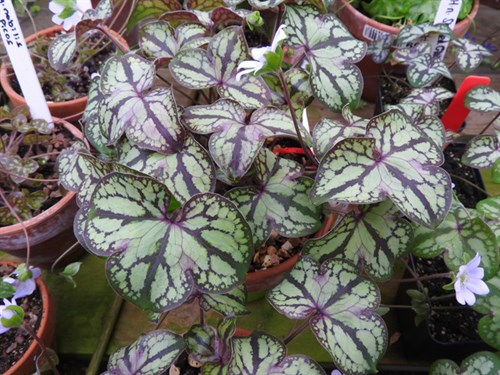
A lovely pic of John in full flow about his
beloved hepaticas.
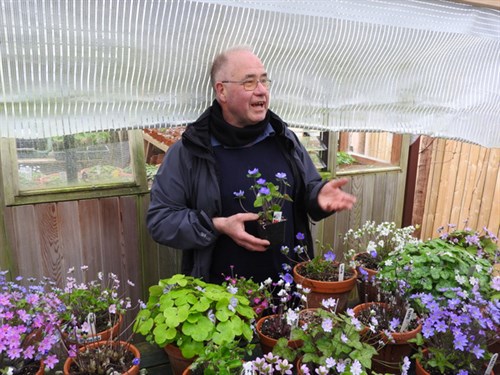
Having started with daffodils it seems only right to finish the
March News with them. This time we were on the trail of
the true wild British daffodil - narcissus pseudonarcissus which
unlike the Derwydd Daffodil is a species with proven
authenticity.
Newent in Gloucestershire was our destination, and in
particular the golden triangle between Dymock, Kempley and
Oxenhall . Along the road verges, fields, in churchyards and woods
they can be found, often in the company of some our best loved wild
spring flowers.

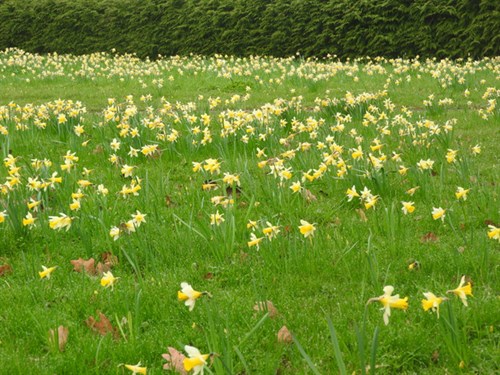
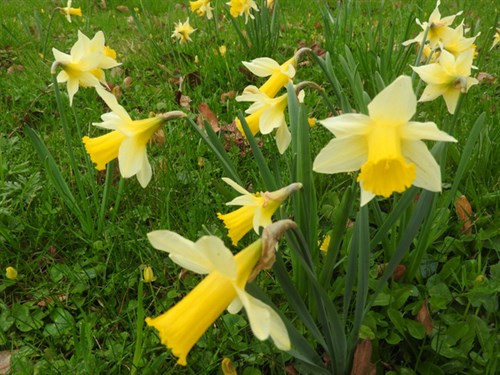
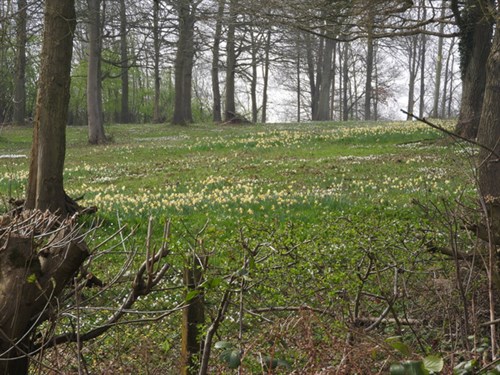
At the edge of a ditch alongside a road we found this
charming grouping with caradamine pratensis (Ladies Smock or
Cuckoo Flower) in the palest shade of lavender which was difficult
to capture on a dull grey day. Also in the mix but hidden in the
long grass were violets and wood anemones
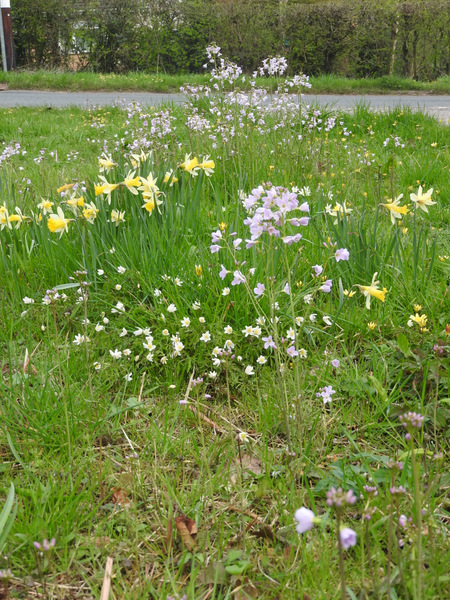
There is form of wood anemone in the area which
seems more vigorous then those in our part of the world, with
larger more intense white flowers. Possibly the result of growing
in incredibly rich red sandstone soil or is it a different
clone?
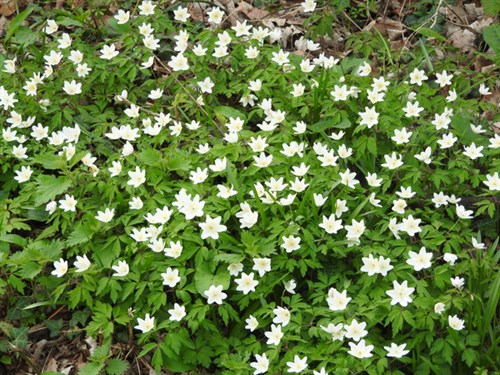
The local villages hold daffodil walks over several weekends
in March and April, with local guides and teas served, but on
any day of the week,you can make your own way by car, along the
lanes, on foot across fields on public footpaths and in woodlands.
For more information go to www.daffs.org.uk In
Oxenhall there is a final daffodil weekend on 8 and 9 April. Type
Oxenhall Daffodil weekends 2017 into your search engine to
find out more
As I said at the beginning they are much loved in those
areas of the UK where they predominate, and in Gloucestershire, of
which it is the county flower, there are charming tales many years
ago of local schoolchildren helping to pick them at weekends for
sale in London to make money for the local communities.
Although of course it is now illegal to pick wildflowers on this
scale, what a lovely way for children to spend their spare time,
knee deep in nature in the great outdoors, a memory of my own
chidhood that still burns deep within me
Finally the answer to the earlier question is that
the plant in the picture is a large clump of tubers from impatiens
flananganae which yielded 11 separate divisons for potting up,
which like a dahlia should flower later this year. Being only just
hardy it needs humus rich soil in a protected situation in part
shade. Pink flowers to 4 feet tall
An exceptionally long News this month so many thanks for
reading and happy gardening at the best time of year.